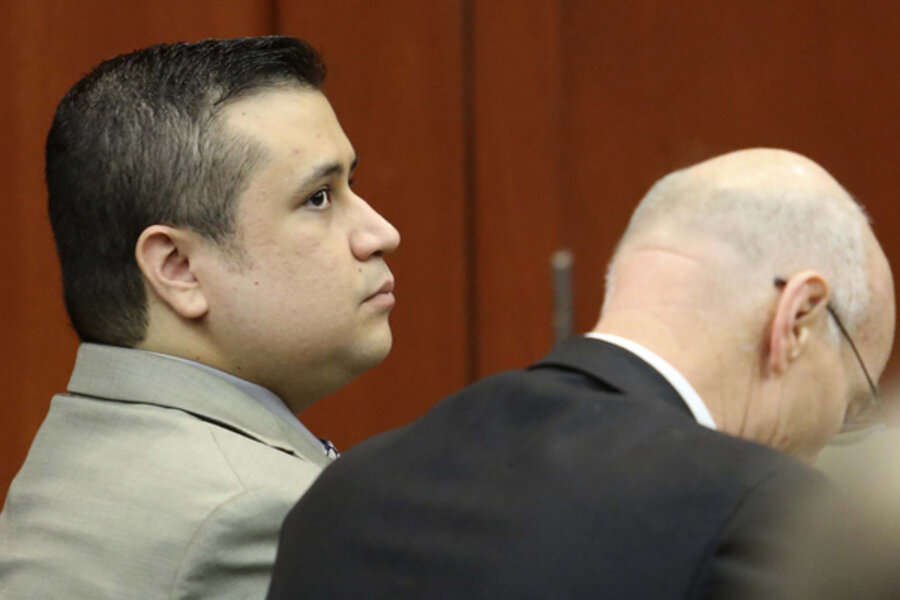Judge in George Zimmerman trial to rule: Can experts testify about 911 calls?
Loading...
| Atlanta
In one analysis of 911 tapes that record Trayvon Martin’s last moments alive, his killer, George Zimmerman, is deemed to utter a cryptically religious aside – “These shall be” – and then Trayvon is interpreted as yelling, “I’m begging you” and “stop!”
That analysis, put forward in a May 15 report by audio expert Alan Reich, a state forensics consultant, is potentially devastating for Mr. Zimmerman’s defense, whose trial is to begin Monday.
On Thursday, the Seminole County circuit judge presiding over the case, Debra Nelson, begins two days of hearings on whether the jury can consider that analysis – or whether it is, as critics suggest, “voodoo forensics” that should be discarded as hearsay.
The hearing will also take up whether other analyses of the 911 calls should be weighed by the jury. But the analysis by Mr. Reich is considered the key one at issue.
Since Trayvon can’t testify at the trial and the majority of eyewitness accounts are murky at best, the snippets of voices that can be heard deep in the background of several 911 calls have held crucial but elusive clues for a central question the jury will be deciding: Did Zimmerman truly fear for his life when he fired, or did the older man control the situation and fire at a helpless and defensive Trayvon?
The judge already ruled earlier this week that the following are not admissible in court: texts, social-media conversations, and photos that show Trayvon referencing pot and guns and indicating a proclivity for getting into fights.
Zimmerman is charged with second-degree murder in the fatal shooting of Trayvon, an unarmed black teenager, on Feb. 26, 2012. A volunteer watchman in a gated Sanford, Fla., neighborhood, Zimmerman described Trayvon, who was wearing a hoodie, as suspicious and followed him despite being told by a 911 dispatcher to wait for police.
After a brief fight, Zimmerman shot Trayvon point-blank in the chest, claiming self-defense. Zimmerman received lacerations to the back of his head and a broken nose from the altercation with Trayvon – the key evidence, besides his own account, that his defense says proves that he’s not guilty.
According to Zimmerman’s account, he pulled out a 9mm pistol from his pants as he lay on his back being pummeled by a person he believed to be a possibly armed adult.
The audiotapes have already been controversial. Media companies hired experts shortly after the shooting to analyze Zimmerman’s 911 call to the police, where he described Trayvon as “suspicious” and at one point complained about “these [expletive], they always get away.” Zimmerman has sued one network for allegedly altering the audio to make it sound like he uttered a racial slur, which most experts now agree he did not.
Born in the midst of World War II intelligence operations, audio forensics have become a crucial law-enforcement tool, employing a whole cadre of experts across the globe who use techniques like adaptive filtering and voice biometrics to decipher and decode hard-to-hear or hard-to-understand recordings. They charge up to $4,500 to analyze an hour’s worth of recording and up to $2,500 per hour for court time.
A number of audio experts have gone over the available tapes, especially two recordings known as “Call 1” – Zimmerman’s call to the dispatcher – and “Call 3” – a 911 call from a resident where voices can be heard in the background. Most have agreed that a scream for “help” at the end of Call 3 is Trayvon’s voice.
In his analysis, Reich, too, matches that voice to Trayvon, though he hears the word “stop” instead of “help” before a shot rings out.
Martin’s voice, Reich concludes in his May 15 report, “is younger and he generates much of what some observers have called screams.” He continues, “The two males are engaged in a loud, purposeful, mostly ‘turn-taking’ linguistic dialogue. The speech associated with the confrontation is often quite difficult to understand, but is amenable to individualized digital enhancement and computer-aided transcription, using an interactive, segment-by-segment approach.”
Zimmerman’s lawyers will fight to bar the analysis by Reich, who likens Zimmerman's vocalization at one point to that of a “carnival barker.”
Robert Zimmerman, Zimmerman’s brother, told CBS News on Wednesday that Reich “is hearing what no one else is able to hear.” He added, “Experts that reach conclusions that can’t be re-created by any other person flies in the face of the very definition of science.”






